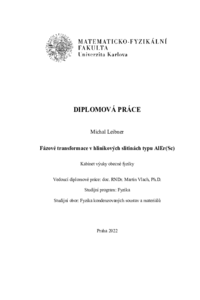Fázové transformace v hliníkových slitinách typu AlEr(Sc)
Phase transformations in aluminium AlEr(Sc)-based alloys
diploma thesis (DEFENDED)

View/
Permanent link
http://hdl.handle.net/20.500.11956/185453Identifiers
Study Information System: 217201
Collections
- Kvalifikační práce [11963]
Author
Advisor
Consultant
Kodetová, Veronika
Kudrnová, Hana
Referee
Minárik, Peter
Faculty / Institute
Faculty of Mathematics and Physics
Discipline
Physics of Condensed Matter and Materials
Department
Laboratory of General Physics Education
Date of defense
13. 9. 2023
Publisher
Univerzita Karlova, Matematicko-fyzikální fakultaLanguage
Czech
Grade
Excellent
Keywords (Czech)
DSC|elektronová mikroskopie|precipitace|aktivační energieKeywords (English)
DSC|electron microscopy|precipitation|activation energyByly studovány vlivy příměsi Sc, různých koncentrací Er a deformace na precipitační procesy ve slitinách Al(-Sc)-Er-Zr. Ve všech studovaných slitinách byly během izochronního žíhání pozorovány tři procesy. První nevýrazný s maximem kolem 240 řC s velkou pravděpodobností odpovídá shlukování atomů Er, resp. Er a Sc. V deformovaném materiálu je tento efekt výraznější, což je dáno snazší difuzí příměsí podél dislokací a hranic (sub)zrn. Druhý proces s maximem okolo 360 řC je dán tvorbou částic Al3Er, resp. Al3(Er,Sc). Ve slitině s přídavkem Sc je tento efekt výraznější a vede k většímu vytvrzení. Třetí proces s maximem na přibližně 500 řC patrně odpovídá tvorbě obálky bohaté na Zr okolo dříve vzniklých precipitátů. Po stárnutí na 600 řC byly ve slitině Al-Er-Zr pozorovány částice se středem tvořeným fází Al3Er a obálkou tvořenou fází Al3(Er,Zr).
The effects of Sc addition, different Er concentrations and deformation on phase transitions in Al(-Sc)-Er-Zr alloys were studied. Three distinct processes were identified during isochronal annealing in all of the alloys investigated. The first process with maximum at ~ 240 řC is probably related to clustering of Er or to clustering of Er and Sc atoms, respectively. This effect was more pronounced in the deformed alloy due to easier diffusion of solutes along dislocations and (sub)grain boundaries. The second process with a maximum around 360 řC stems from the formation of Al3Er or Al3(Er,Sc) particles, respectively. This effect was more pronounced and led to a more significant hardening in the Sc-containing alloy. The third process is most likely related to the formation of Zr-rich shell around the previously formed precipitates. After aging at 600 řC, precipitates with a core made of Al3Er phase and a shell made of Al3(Er,Zr) phase were observed in the Al-Er-Zr alloy.
